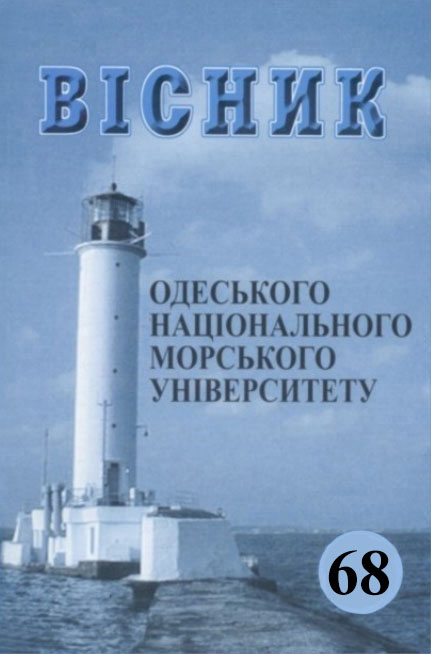About changing the parameters of sea containers
Main Article Content
Abstract
Cargo containers used in sea transport are considered. The ISO classification of containers by purpose, design, size and weight is provided. Data on the share of use in sea transportation of the main types of large-tonnage containers are given. The concept of «ISO container module» and the analysis of its application for containers used in cargo transportation are presented. Certain disadvantages of container transportation of general cargo and the impact of these disadvantages on the development of requirements and design features of containers are considered. The «group codes» of containers entered during international sea transportation are provided, which are used for the convenience of their identification. An analysis of the influence of the «ISO container module» on the structural features of sea vessels and, based on this, on the prevalence of large-tonnage containers of a certain size, is presented. A list of containers of various lengths used in sea transportation that do not meet the ISO standard is given. An assumption is given that justifies the appearance of such diversity. Attention is drawn to the change over time in the classification of containers according to ISO standards and the appearance of some uncertainty in them regarding their weight. Which leads to the constant need to check the labeling of containers with their actual gross weight. The influence of the increase in the carrying capacity of container carriers and the development of transshipment equipment on the requirements for the strength of containers and the possible height of their storage is considered. It is concluded that, despite the presence of a wide range of containers, the largest number of them are containers of a limited type. Requirements for strength, and accordingly the weight of containers, will increase.
Article Details
References
2. Tykhonіn V.І. Vantazhoznavstvo. Navchal'nyj posіbnyk. – Odesa: ONMU, 2016. – 236 s.
3. Tykhonіn V.І. Vantazhoznavstvo. Konspekt lektsіj. – Odesa: Magіstr, 2017. – 136 s.
4. Kozyrjev V.K. Vantazhovedennya: Pіdruchnyk. – Vyd. 2-e, vypr. і dop. – O.: Fenіks; M.: RKonsul't, 2005. – 360 s.
5. Snopkov V.Y. Tekhnologyya perevozky gruzov morem: Uchebnyk dlya vuzov. 3-e yzd., pererab. y dop. – S. Peterburg: ANO NPO «Myr y Sem'ya», 2001 g. 560 s.
6. Prudnykova V.P. Kontejner – kak sredstvo perevozky gruzov: Uchebnoe posobye. – Vladyvostok: MGU ym. adm. G.Y. Nevel'skogo, 2009. – 29 s.
7. Osnovy gruzovedeniya: Ucheb. posobie dlya stud. vyssh. ucheb. zavedenij / E.M. Oleshchenko, A.Je. Gorev. – M.: Izdatel'skij tsentr «Akademiya», 2005. – 288 s.
8. GOST 20231-83 Kontejnery gruzovye. Terminy i opredeleniya. – URL: https://docs.cntd.ru/document/1200006866
9. GOST R 52202-2004 (ISO 830-99) Kontejnery gruzovye. Terminy i opredeleniya. – URL: https://files.stroyinf.ru/Data2/1/4294813/4294813220.pdf
10. Mezhdunarodnye kontejnernye perevozki. – URL: http://professionkonspect.org/?content=3362
11. GOST R 53350-2009 (ISO 668:1995) Kontejnery gruzovye serii 1. Klassifikatsiya, razmery i massa. – URL: http://docs.cntd.ru/document/gostr-53350-2009
12. Oboznacheniya tipy morskikh kontejnerov. – URL: http://xn--e1aalcpcdvn.com/konteynery-v-saratove/morskie-konteynery/
13. Identifikatsiya i markirovka kontejnerov. – URL: https://star-shineshipping.com/ru/spravochniki/markirovka-kontejnera.html
14. Gabarity kontejnerov. – URL: http://hermes-cargo.ru/gabarity-konteynerov
15. 53-futovyj stal'noj transportirovochnyj kontejner. – URL: https://russian.alibaba.com/product-detail/53-foot-steel-shipping-container-60255506952.html
16. GOST R 52524-2019 (ISO 6346:1995) Kontejnery gruzovye. Kodirovanie, identifikatsiya i markirovka. – URL: http://docs.cntd.ru/document/1200167462
17. Terminy, sokrashcheniya i abbreviatury, ispol'zuemye v mezhdunarodnykh kontejnernykh perevozkakh. – URL: https://www.vdnk.ru/site/ru/infocontainer/port-charges#COM
18. Oboznacheniya tipy morskikh kontejnerov. – URL: http://xn--e1aalcpcdvn.com/konteynery-v-saratove/morskie-konteynery/
19. Kontejnerovoz. – URL: https://ru.wikipedia.org/wiki/Kontejnerovoz
20. GOST 20259-80 Kontejnery universal'nye. Obshchie tekhnicheskie usloviya. – URL: http://docs.cntd.ru/document/gost-20259-80
